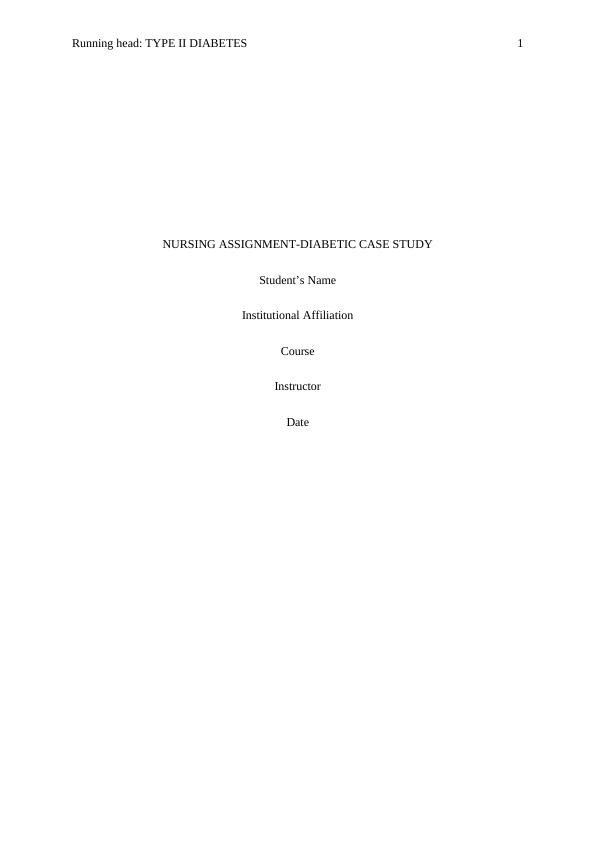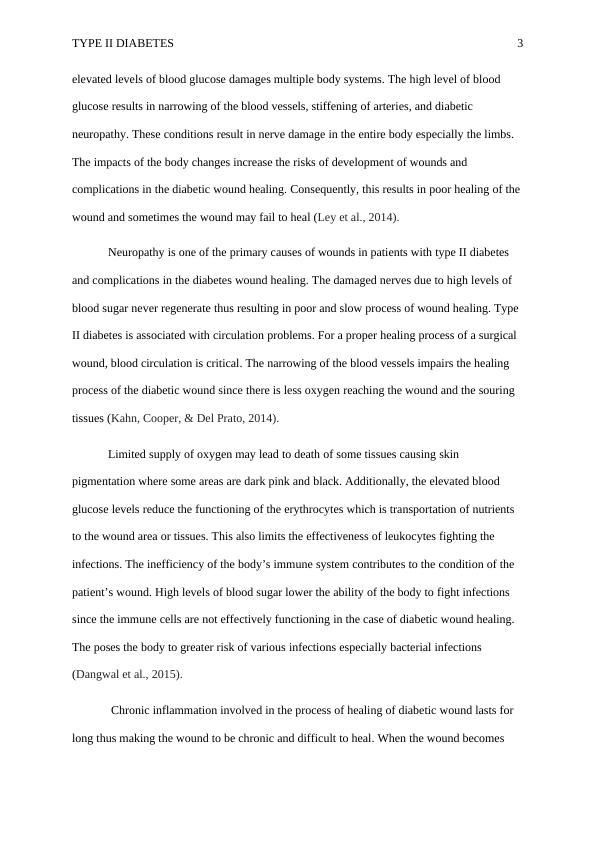Nursing Assignment-Diabetic Case Study
Added on 2023-01-09
10 Pages2911 Words36 Views
Running head: TYPE II DIABETES 1
NURSING ASSIGNMENT-DIABETIC CASE STUDY
Student’s Name
Institutional Affiliation
Course
Instructor
Date
NURSING ASSIGNMENT-DIABETIC CASE STUDY
Student’s Name
Institutional Affiliation
Course
Instructor
Date

TYPE II DIABETES 2
Introduction
The essay will discuss the case study of Mrs. Gina Bacci who is 48 years and has been
amputated following a complication of right foot ulcer. She has a history of obesity, Type II
diabetes, and Peripheral Vascular Disease (PVD). Due to exacerbation of diabetes, she is
currently on insulin regimen. With regard to the case study, the essay will apply the Clinical
Reasoning Cycle to first, analyze and discuss the pathophysiology and causative factors of
Mrs. Bacci’s status of the wound after operation. Secondly, using the same concept, the paper
will identity two major nursing priorities for care of Mrs Bacci. Thirdly, the paper will
outline and discuss the appropriate nursing management for the patient.
Question 1: Based on the case study, critically analyse and discuss the underlying
pathophysiology and causes of the patient’s post-operative wound status
On assessment, the patient’s wound has an Island of film dressing wet from a serous
exudate along the incisional wound and some dehiscence and sloughy tissue along the suture
line. Additionally, the skin area around the wound was warm, painful when touched, and dark
pink. These findings are an indication of infection and poor wound healing. Dehiscence is
one of the surgical wound complications whereby there is a rapture along the surgical
incision. Some of the risk factors for the development of a dehiscence include obesity,
diabetes, and infection. Slough tissue is a necrotic tissue which has separated from the wound
and it’s a sign of an infection in a surgical wound. Generally, the condition and healing
process of the wound is poor (Ley, Hamdy, Mohan, & Hu, 2014).
The poor healing process of the patient’s wound can be attributed to her history of
obesity, PVD, and type II diabetes. These conditions impact the wound healing process in
different ways. In type II diabetes, the high levels of glucose in blood inhibits the ability of
the body to effectively regulate glucose thus making the patient have difficulties in the
maintenance of an optimum level of blood sugar (Al-Goblan, Al-Alfi, & Khan, 2014). The
Introduction
The essay will discuss the case study of Mrs. Gina Bacci who is 48 years and has been
amputated following a complication of right foot ulcer. She has a history of obesity, Type II
diabetes, and Peripheral Vascular Disease (PVD). Due to exacerbation of diabetes, she is
currently on insulin regimen. With regard to the case study, the essay will apply the Clinical
Reasoning Cycle to first, analyze and discuss the pathophysiology and causative factors of
Mrs. Bacci’s status of the wound after operation. Secondly, using the same concept, the paper
will identity two major nursing priorities for care of Mrs Bacci. Thirdly, the paper will
outline and discuss the appropriate nursing management for the patient.
Question 1: Based on the case study, critically analyse and discuss the underlying
pathophysiology and causes of the patient’s post-operative wound status
On assessment, the patient’s wound has an Island of film dressing wet from a serous
exudate along the incisional wound and some dehiscence and sloughy tissue along the suture
line. Additionally, the skin area around the wound was warm, painful when touched, and dark
pink. These findings are an indication of infection and poor wound healing. Dehiscence is
one of the surgical wound complications whereby there is a rapture along the surgical
incision. Some of the risk factors for the development of a dehiscence include obesity,
diabetes, and infection. Slough tissue is a necrotic tissue which has separated from the wound
and it’s a sign of an infection in a surgical wound. Generally, the condition and healing
process of the wound is poor (Ley, Hamdy, Mohan, & Hu, 2014).
The poor healing process of the patient’s wound can be attributed to her history of
obesity, PVD, and type II diabetes. These conditions impact the wound healing process in
different ways. In type II diabetes, the high levels of glucose in blood inhibits the ability of
the body to effectively regulate glucose thus making the patient have difficulties in the
maintenance of an optimum level of blood sugar (Al-Goblan, Al-Alfi, & Khan, 2014). The

TYPE II DIABETES 3
elevated levels of blood glucose damages multiple body systems. The high level of blood
glucose results in narrowing of the blood vessels, stiffening of arteries, and diabetic
neuropathy. These conditions result in nerve damage in the entire body especially the limbs.
The impacts of the body changes increase the risks of development of wounds and
complications in the diabetic wound healing. Consequently, this results in poor healing of the
wound and sometimes the wound may fail to heal (Ley et al., 2014).
Neuropathy is one of the primary causes of wounds in patients with type II diabetes
and complications in the diabetes wound healing. The damaged nerves due to high levels of
blood sugar never regenerate thus resulting in poor and slow process of wound healing. Type
II diabetes is associated with circulation problems. For a proper healing process of a surgical
wound, blood circulation is critical. The narrowing of the blood vessels impairs the healing
process of the diabetic wound since there is less oxygen reaching the wound and the souring
tissues (Kahn, Cooper, & Del Prato, 2014).
Limited supply of oxygen may lead to death of some tissues causing skin
pigmentation where some areas are dark pink and black. Additionally, the elevated blood
glucose levels reduce the functioning of the erythrocytes which is transportation of nutrients
to the wound area or tissues. This also limits the effectiveness of leukocytes fighting the
infections. The inefficiency of the body’s immune system contributes to the condition of the
patient’s wound. High levels of blood sugar lower the ability of the body to fight infections
since the immune cells are not effectively functioning in the case of diabetic wound healing.
The poses the body to greater risk of various infections especially bacterial infections
(Dangwal et al., 2015).
Chronic inflammation involved in the process of healing of diabetic wound lasts for
long thus making the wound to be chronic and difficult to heal. When the wound becomes
elevated levels of blood glucose damages multiple body systems. The high level of blood
glucose results in narrowing of the blood vessels, stiffening of arteries, and diabetic
neuropathy. These conditions result in nerve damage in the entire body especially the limbs.
The impacts of the body changes increase the risks of development of wounds and
complications in the diabetic wound healing. Consequently, this results in poor healing of the
wound and sometimes the wound may fail to heal (Ley et al., 2014).
Neuropathy is one of the primary causes of wounds in patients with type II diabetes
and complications in the diabetes wound healing. The damaged nerves due to high levels of
blood sugar never regenerate thus resulting in poor and slow process of wound healing. Type
II diabetes is associated with circulation problems. For a proper healing process of a surgical
wound, blood circulation is critical. The narrowing of the blood vessels impairs the healing
process of the diabetic wound since there is less oxygen reaching the wound and the souring
tissues (Kahn, Cooper, & Del Prato, 2014).
Limited supply of oxygen may lead to death of some tissues causing skin
pigmentation where some areas are dark pink and black. Additionally, the elevated blood
glucose levels reduce the functioning of the erythrocytes which is transportation of nutrients
to the wound area or tissues. This also limits the effectiveness of leukocytes fighting the
infections. The inefficiency of the body’s immune system contributes to the condition of the
patient’s wound. High levels of blood sugar lower the ability of the body to fight infections
since the immune cells are not effectively functioning in the case of diabetic wound healing.
The poses the body to greater risk of various infections especially bacterial infections
(Dangwal et al., 2015).
Chronic inflammation involved in the process of healing of diabetic wound lasts for
long thus making the wound to be chronic and difficult to heal. When the wound becomes

End of preview
Want to access all the pages? Upload your documents or become a member.
Related Documents
Type II Diabetes: Pathophysiology, Causes, and Nursing Managementlg...
|11
|3177
|113
Pathophysiological Assessment and Nursing Care Priorities on Case Study Reviewlg...
|9
|2534
|342
Principles of Nursing: Surgicallg...
|11
|2904
|102
Diabetes Management Case Studylg...
|10
|3057
|65
Nursing Case Study: Pathophysiology, Nursing Priorities, and Managementlg...
|13
|3628
|69
Case Study: Nursing Management of Surgical Wound Complicationslg...
|12
|3120
|52
